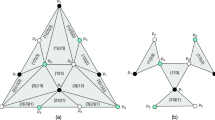Abstract
The proliferation of cheap portable, wireless computing devices (e.g., cell phones and PDAs) promises the availability of a large number of computing devices in a relatively small geographic region. Researchers have proposed using such an ensemble of wireless devices to create a wireless ad-hoc lattice computer (WAdL) to harness the collective computing capabilities of the devices for the common cause of scientific computing via analogical simulations. Faulty devices or lack of wireless coverage leads to “gaps” in a WAdL, rendering it ineffective for analogical simulations.
In this paper we discuss our soultion to the problem of bridging gaps in WAdLs by assigning active devices on the perimeter of the gap as proxies for the defective devices in the gap. We establish lower bounds on the communication dilation witnessed by such proxy assignments for single-row gaps and general row-column convex gaps, and present dilation-optimal, constant time algorithms for computing proxy assignments for single-row gaps and gaps that are rectangular in shape.
This research was supported, in part, by the European Research Project Algorithmic Principles for Building Efficient Overlay Computers (AEOLUS). Most of the work reported here was performed while Professor A. Shende visited the Department of Computer Science, University of Rome “La Sapienza”. Support through a Visiting Fellowship from the University of Rome “La Sapienza” is gratefully acknowledged.
Preview
Unable to display preview. Download preview PDF.
Similar content being viewed by others
References
Aigner, M., Ziegler, G.M.: Proofs from the book. Springer, Heidelberg (2004)
Case, J., Rajan, D.S., Shende, A.M.: Lattice computers for approximating euclidean space. Journal of the ACM 48(1), 110–144 (2001)
Chrobak, M., Dürr, C.: Reconstructing hv-convex polyominoes from orthogonal projections. Information Processing Letters 69, 283–289 (1999)
Frisch, U., Hasslacher, B., Pomeau, Y.: Lattice-gas automata for the Navier Stokes equation. Physical Review Letters 56(14), 1505–1508 (1986)
Greenspan, D.: Deterministic computer physics. International Journal of Theoretical Physics 21(6-7), 505–523 (1982)
Gupta, V., Mathur, G.: Wireless Ad-hoc Lattice computers (WAdL). In: 18th Annual Consortium for Computing Sciences in Colleges: Southeastern Conference (2004)
Gupta, V., Mathur, G., Shende, A.M.: Lattice formation in a WAdL Wireless Ad-hoc Lattice computer. In: Workshop on Algorithms for Wireless and Mobile Networks (2004)
Hillis, W.D.: The connection machine: A computer architecture based on cellular automata. Physica D 10, 213–228 (1984)
Keidar, I., Schuster, A.: Want scalable computing?: speculate! SIGACT News 37(3), 59–66 (2006)
Kuba, A.: The reconstruction of two-directional connected binary patterns from their two orthogonal projections. Computer Vision, Graphics, Image Processing 27, 249–265 (1984)
Margolus, N.: CAM-8: a computer architecture based on cellular automata. In: Lawniczak, A., Kapral, R. (eds.) Pattern Formation and Lattice-Gas Automata (1993)
Moore, P., Shende, A.M.: Gaps in wireless ad-hoc lattice computers. In: International Symposium on Wireless Communication Systems (2005)
Shende, A.M.: Digital analog simulation of uniform motion in representations of physical n-space by lattice-work mimd computer architectures, Ph.D. dissertation, SUNY, Buffalo (1991)
Yepez, J.: Lattice-gas dynamics, vol. I, viscous fluids. Technical Report 1200, Phillips Laboratories, Environmental Research Papers (November 1995)
Author information
Authors and Affiliations
Editor information
Rights and permissions
Copyright information
© 2007 Springer Berlin Heidelberg
About this paper
Cite this paper
Calamoneri, T., Fusco, E.G., Shende, A.M., Shende, S.M. (2007). Proxy Assignments for Filling Gaps in Wireless Ad-Hoc Lattice Computers. In: Prencipe, G., Zaks, S. (eds) Structural Information and Communication Complexity. SIROCCO 2007. Lecture Notes in Computer Science, vol 4474. Springer, Berlin, Heidelberg. https://doi.org/10.1007/978-3-540-72951-8_17
Download citation
DOI: https://doi.org/10.1007/978-3-540-72951-8_17
Publisher Name: Springer, Berlin, Heidelberg
Print ISBN: 978-3-540-72918-1
Online ISBN: 978-3-540-72951-8
eBook Packages: Computer ScienceComputer Science (R0)




